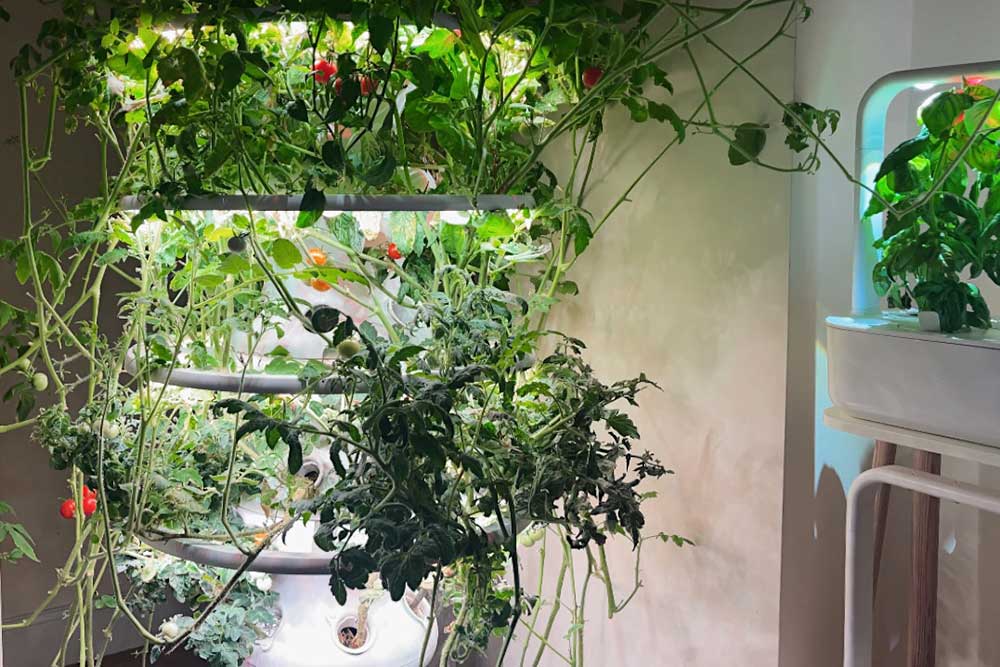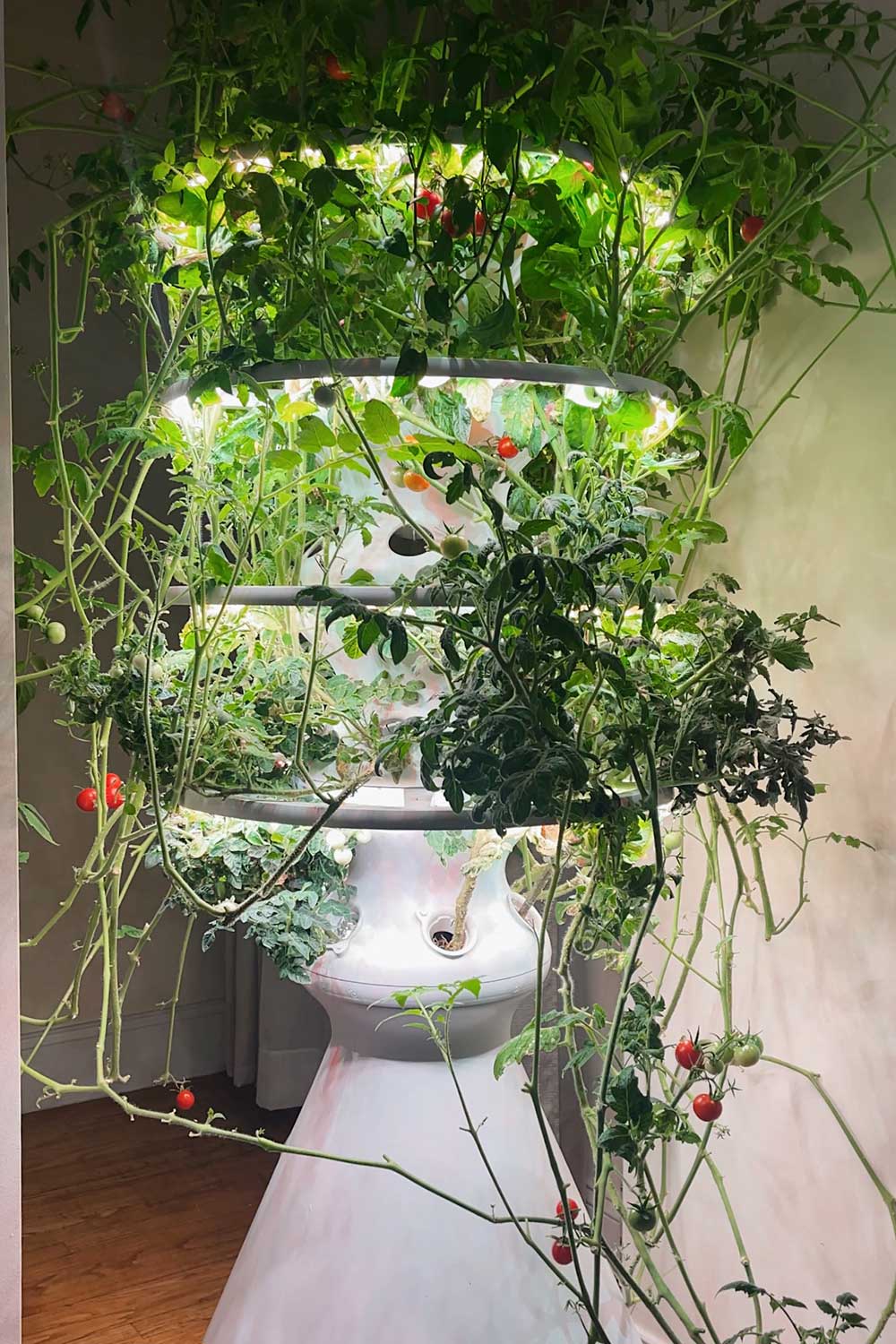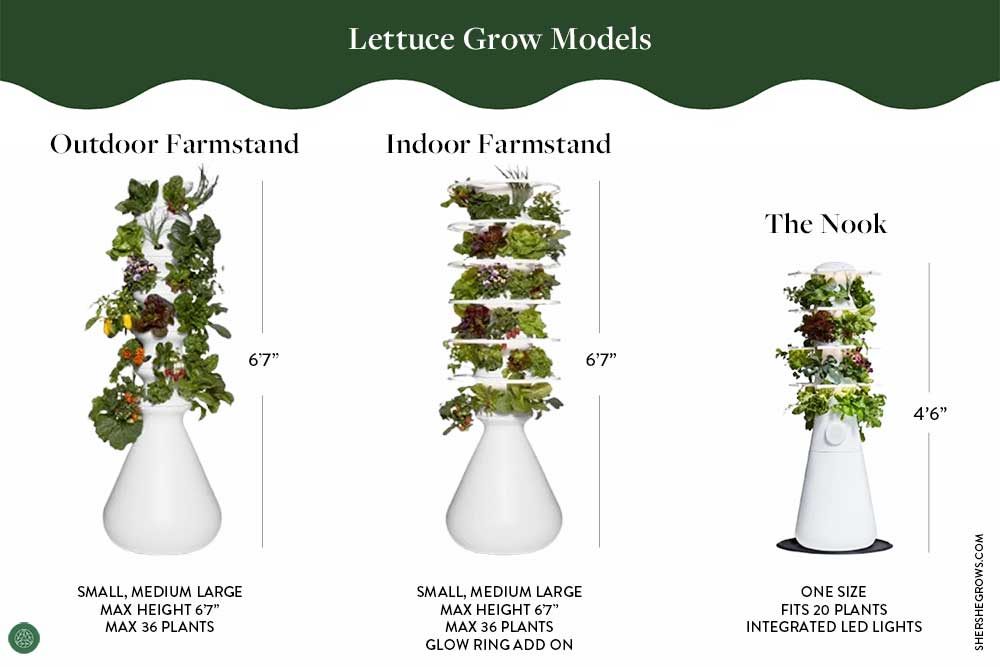
If you’ve been thinking about growing fresh greens at home with Lettuce Grow’s indoor gardens, you might be wondering:
How much will this add to my electricity bill?
Sure, homegrown lettuce, herbs, and veggies are a game-changer, but no one wants a surprise spike in energy costs.
The good news?
Running a hydroponic garden is more energy-efficient than you might think!
In today’s article, I’m breaking down the actual electricity usage of every indoor garden Lettuce Grow offers: the Farmstand, Nook, etc!
I’ll also show you how to estimate the cost based on your location.
That way, you’ll have a clear idea of what to expect, so you can enjoy fresh, homegrown produce without any guesswork.
Lettuce Grow Electric Costs, by Model
| Model | Plants | Watts Used | Monthly Cost | Annual Cost |
| Nook | 20 | 37.5 W | $2.14 | $26.07 |
| Outdoor Farmstand | 36 | 24 W | $0.46 | $5.55 |
| Indoor Farmstand (small) | 12 | 67 W | $3.32 | $40.36 |
| Indoor Farmstand (medium) | 24 | 101 W | $5.58 | $67.88 |
| Indoor Farmstand (large) | 36 | 135 W | $9.43 | $114.65 |
*assuming electricity supply costs of 15.84 cents per kWh.

Electric rates fluctuate from month to month based on supply, seasonality and location.
I live in New York City where we’re currently paying about 41.1% higher than the national average, so my costs are on the higher end!1
You can look at your utility bill to find your local electric supply rates so you can calculate your costs.
1 In November 2024, average New York residential electricity rates were 24.69 cents per kwH compared to the national average of 17.01 cents per kwH.
Overall, indoor gardens are pretty energy efficient!
An outdoor Farmstand uses 24 watts of power, about the energy of a single light bulb.
The indoor Nook and Farmstand will draw a bit more energy, since they use built-in lights to grow plants indoors where sunlight doesn’t reach.
But, Lettuce Grow’s indoor gardens still top out at a very minimal 38 – 135 watts of power.
Compare that to common household appliances, like a:
- TV: 50 – 200 watts
- desktop computer: 200 – 500 watts
- refrigerator: 300 – 800 watts
- AC unit: 1,000 – 3,500 watts
- washing machine: 400 – 1,400 watts
- water heater: 1,000 – 5,000 watts
Essentially, adding a giant tower garden to your home is about the same as adding another TV or computer!
How to Calculate Lettuce Grow Electricity Costs
I put together the chart above as a neat summary for each garden Lettuce Grow offers.
But if you want to calculate exactly how much a smart garden costs to run, here’s the formula:
Energy Usage Cost Formula
(kilowatts used) x (cost per kilowatt hour) * (hours a day the garden is on) x (# of days)
Note: utility companies charge in kilowatts so you’ll need to make sure to divide the wattage for small appliances like this by 1000, to convert to kilowatts
Essentially, you take the garden’s energy usage and multiply it by the number of hours that the garden is on.
Then, take that daily usage and multiply it by your local electricity rate to get a daily garden cost.
You can take the daily cost and extrapolate to reach a monthly cost and yearly cost.
How Much Energy Lettuce Grow Uses
Ok, on to the math.
Lettuce Grow sells 2 different types of gardens: the Nook and the Farmstand.
They vary in size, with the small Nook designed exclusively for indoor use while the large Farmstand can be used indoors and outdoors.
The Nook comes in just 1 fixed size, with space for 20 plants. The LED lights are integrated with the garden and use less power, designed for growing lower maintenance plants like herbs and leafy greens.
The Farmstand is a modular system available in 3 larger sizes. If set up for indoor use, you’ll use their Glow Rings to provide lighting. These LED lights are more powerful, designed for a full spectrum growing experience.

a comparison of Lettuce Grow’s models. the Farmstand, being larger with more powerful LEDs, will use more energy than the compact Nook
Electric Supply Costs
Let’s assume a 15.84 cents per kWh electric supply cost.
The actual rate changes every month, but I want to keep the rate consistent with the Aerogarden energy calculation I previously wrote.
That way, you can get an idea of Lettuce Grow’s indoor garden costs and compare them to Aerogardens’s gardens as well.
Read more: How Much My Aerogardens Add to My Electric Bill
Number of Hours a Day the Garden is On
Lettuce Grow’s gardens use electricity in two main parts:
- the water pump
- the lights
Since each garden is a different size, with slightly different features, they vary in usage. Below are the brand’s suggested settings for each garden.
Nook Light Schedule
| Timer Settings | Lights On | Lights Off |
| Nook | 14 hrs | 10 hrs |
Nook Water Pump Schedule
| Pump Settings | Day | Night |
| Nook | 2 min on/ 58 min off | 2 min on/ 178 min off |
Timer schedules based on Lettuce Grow’s Nook assembly guide.
Indoor Farmstand Light Schedule
| Timer Settings | Lights On | Lights Off |
| 2-4 Glow Rings | 14 hrs | 10 hrs |
| 5 Glow Rings | 15 hrs | 9 hrs |
| 6 Glow Rings | 17 hrs | 7 hrs |
Timer schedules based on Lettuce Grow’s Farmstand assembly guide.
Indoor Farmstand Water Pump Schedule
| Pump Settings | Day | Night |
| Farmstand | 15 min on/ 45 min off | 15 min on/ 165 min off |
Pump schedules based on Lettuce Grow’s Farmstand assembly instructions.
Lettuce Grow Indoor Garden Usage
So based on these settings, we’ll calculate electricity usage for each garden’s lights as follows:
- 14 hours for the Nook
- 0 hours for the Outdoor Farmstand
- 14 hours for the Small Indoor Farmstand (2 glow rings)
- 14 hours for the Medium Indoor Farmstand (4 glow rings)
- 17 hours for the Large Indoor Farmstand (6 glow rings)
…and we’ll calculate electricity usage for each garden’s water pump as follows:
- 32 minutes in a day for the Nook
- 240 minutes in a day for the Outdoor Farmstand 1
- 240 minutes in a day for all Indoor Farmstand models
1 Lettuce Grow recommends different water pump schedules based on your outdoor temperature. For ease of calculation, I assumed their ‘warm’ growing conditions with average daily temperatures between 65° – 85° F. Coincidentally, this is the same water pump schedule as their ‘indoor’ growing condition, with 15 minutes on / 45 minutes off during the day and 15 minutes on / 165 minutes off at night.
Lettuce Grow Electricity Costs
For anyone curious about the math, here are the actual electricity usage calculations for each Lettuce Grow indoor garden:
Lettuce Grow Nook Electricity Cost
The Nook water pump uses 5.5 watts of power while the LED lights consume 32 watts.
(.0055 kilowatts used x .1584 cents per kWh x 32/60 hours a day x 30 days) + (.032 kw x .1584 cents per kWh x 14 hours a day x 30 days) = $2.14 cents per month
(.0055 kilowatts used x .1584 cents per kWh x 32/60 hours a day x 365 days) + (.032 kw x .1584 cents per kWh x 14 hours a day x 365 days) = $26.07 dollars per year
Lettuce Grow Outdoor Farmstand Electricity Cost
The Farmstand water pump uses 24 watts of power.
.024 kilowatts used x .1584 cents per kWh x 240/60 hours a day x 30 days = $0.46 cents per month
.024 kilowatts used x .1584 cents per kWh x 240/60 hours a day x 365 days = $5.55 cents per month
Lettuce Grow Small Indoor Farmstand Electricity Cost
The Indoor Farmstand uses 43 watts for the first 2 glow rings.
$0.46 + (.043 kilowatts x .1584 c/kWh x 14 hours a day x 30 days) = $3.32 cents per month
$5.55 + (.043 kilowatts used x .1584 cents per kWh x 14 hours a day x 365 days) = $40.36 dollars per year
Lettuce Grow Medium Indoor Farmstand Electricity Cost
The Indoor Farmstand uses 43 watts for the first 2 glow rings and 17 watts for each additional tier.
$0.46 + (.077 kilowatts x .1584 c/kWh x 14 hours a day x 30 days) = $5.58 cents per month
$5.55 + (.077 kilowatts used x .1584 cents per kWh x 14 hours a day x 365 days) = $67.88 dollars per year
Lettuce Grow Large Indoor Farmstand Electricity Cost
$0.46 + (.111 kilowatts x .1584 c/kWh x 17 hours a day x 30 days) = $9.43 cents per month
$5.55 + (.111 kilowatts used x .1584 cents per kWh x 17 hours a day x 365 days) = $114.65 dollars per year
Overall, even the largest Indoor Farmstand is relatively affordable, at under $10 a month!
Considering how much I’m able to grow on the 36 plant tower, I personally think it’s worth it to grow organic, pesticide free heirloom vegetables.
Follow me on